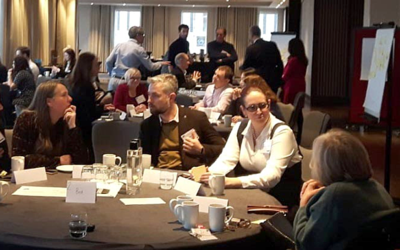 Good design touches our lives every day. From the cars we drive to the beds we sleep in, the equipment and products that we use have been constructed to make our lives easier. But often the design decisions fail to take into account those with physical limitations.
Good design touches our lives every day. From the cars we drive to the beds we sleep in, the equipment and products that we use have been constructed to make our lives easier. But often the design decisions fail to take into account those with physical limitations.
Versus Arthritis is concerned that people with arthritis are missing out because designers have not thought about the challenges they face.
As part of the Room to Manoeuvre campaign, VA want more people to understand the impact of arthritis, and to work together to create solutions so that the equipment and spaces people with arthritis use are more effective.
To support this ambition, on the 23 and 24 January the Versus Arthritis Policy team helped organise a design workshop with the Department for Business, Energy and Industrial Strategy, Department for Health and Social Care, Design Council, the IET, and the Helen Hamlyn Centre for Design. The workshop explored opportunities to design better solutions for people who can find everyday tasks a challenge.
The event was part of the Government’s Ageing Society Grand Challenge – a mission to ensure that people can enjoy at least five extra, healthy, independent years of life by 2035.
Versus Arthritis knows that arthritis steals quality of life from millions of people and believe that it must be a central consideration of the Ageing Grand Challenge.
Caroline Dinenage MP, the Minister of State for Social Care attended part of the workshop. She viewed some of the products that emerged from the Spark product innovation programme (a project we have previously co-sponsored with the Design Council) and met some of the campaigners, who talked to her about their experiences using aids and adaptations.
V ersus Arthritis policy specialist, Ollie Phelan, presented research on the impact products and home adaptations can have for people with arthritis. He shared that “97% of people with arthritis we surveyed told us that home aids and adaptations had a positive impact on their lives. For nearly 80% these products helped them to maintain independence, and for 13% they were the difference between independence and dependence. It’s clear the impact is huge and we must ensure that people with arthritis have good access to the products that could help them live better. But we must also ensure that there is focus on good design. People with arthritis have told us that medicalised products can reinforce feelings of vulnerability and embarrassment. This event is a welcome step in designing life-changing products that anyone would want to use.”
ersus Arthritis policy specialist, Ollie Phelan, presented research on the impact products and home adaptations can have for people with arthritis. He shared that “97% of people with arthritis we surveyed told us that home aids and adaptations had a positive impact on their lives. For nearly 80% these products helped them to maintain independence, and for 13% they were the difference between independence and dependence. It’s clear the impact is huge and we must ensure that people with arthritis have good access to the products that could help them live better. But we must also ensure that there is focus on good design. People with arthritis have told us that medicalised products can reinforce feelings of vulnerability and embarrassment. This event is a welcome step in designing life-changing products that anyone would want to use.”
At the event attendees were split into teams, each made up of people from a variety of backgrounds, including designers, people with arthritis, clinicians, occupational therapists, and engineers. They interrogated the challenge areas they were presented with, identifying particular opportunities for new designs and new products.
Cherine Maskill is one of the campaigners who took part in the workshop. She said:
“I wouldn’t consider myself physically disabled, but arthritis impacts on almost everything I do. I haven’t had a bath in two years as I can’t get in and out of the tub. I struggle with anything where you have to apply pressure through the thumbs or wrists.
“Inclusive design is crucial. You have to step away from the idea that it’s ‘older people’ having a problem and start looking at a universal problem and therefore a universal solution.
“A lightbulb moment for me was where we were breaking down the sequence of actions that take place to actually get in and out of the car. I shared my own experience of this. It really made me realise that it’s the people on the ground with practical experience or professional expertise, who should be involved in the design of new products.”
At the end of the two days, each team presented their ideas. One team envisaged a ‘plug-and-play’ bathroom where components could be switched in and out to adapt to the needs of the inhabitant. One designed a flatpack accessible bed. Another had the idea of self-driving cars that also helped people into the car itself.
These ideas provide serious insight into the challenge areas that designers should focus on when designing equipment that could make a difference to people with arthritis. This information will feed into the ongoing Ageing Grand Challenge work.
Versus Arthritis continues to work closely with the Design Council and the Department of Health and Social Care to ensure people with arthritis remain a central part of the Government’s industrial strategy.
You can find out more on the Versus Arthritis website about the Room to Manoeuvre campaign which aims to ensure that everyone with arthritis has access to the aids and adaptations they need.

